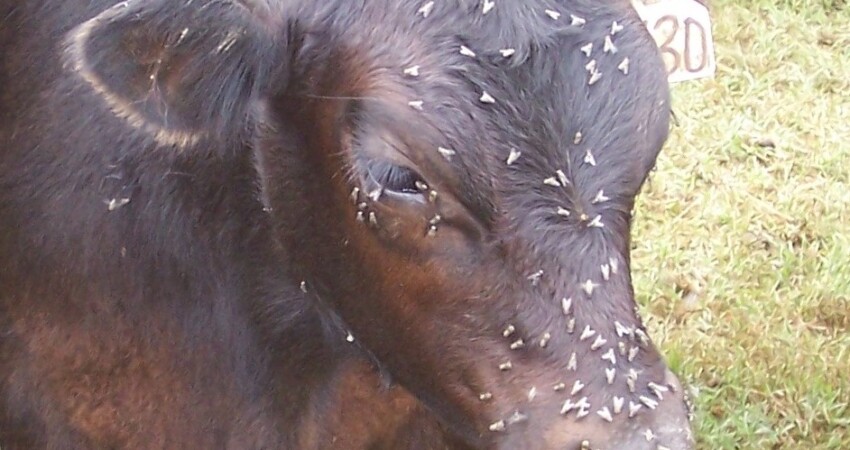

Horn flies, face flies, and stable flies are not just irritants to livestock, but are economically important to producers due to negative impacts on milk production and calf weaning weights. In addition, they can affect grazing distribution and transmit eye diseases such as pinkeye and infectious bovine rhinotracheitis (IBR). It is difficult to predict what fly levels will be like for any given year, but hot, dry weather usually results in high numbers. It is important to understand identification and life cycles of pests affecting livestock in order to choose the most effective control options.
Horn Flies
Horn flies are one of the most common and economically devastating insect pests of the beef industry. They are about 1/2 to 1/3 the size of the common house fly and will commonly be found on the backs, shoulders, sides and poll area of the cattle. During the heat of the day they can be found on the belly. Adult females deposit eggs in fresh manure, and the eggs typically hatch within 1 to 2 days. If left untreated, densities of horn flies may reach several hundred or thousand flies per animal by mid-summer.
If fly populations are high (over 200 flies per animal), treatment may be required. Options include dust bags, feed additives, sprays, pour-ons, and insecticide ear tags. Dust bags or oilers may be either forced-use (placed in an area that animals must pass through) or free choice. They offer good control, but require time to be spent checking and repairing bags. Feed additive products contain insecticides that pass through the animal’s digestive system and kill horn fly larvae in the manure. While these additives are effective in reducing the number of larvae, this does not necessarily correlate to a reduction in the number of adults since flies will migrate to and from neighboring herds.
Face Flies
Face flies resemble house flies but are slightly larger and darker. They are non-biting flies that cluster around animals’ eyes, mouth, and muzzle to feed on animal secretions. Females lay eggs in fresh manure from cattle on pasture, with the complete life cycle taking around 21 days. They are usually most numerous in pastures that have a lot of shaded areas and waterways. Face flies can cause damage to eye tissues, which can predispose animals to infection. Control of these pests is essential in controlling pinkeye. If pinkeye is a recurring problem, it is a good idea for producers to visit with their veterinarian about vaccine options.
Because of the locations on the animal in which face flies feed and the fact that these flies are not on the animal most of the time, control of face flies can be difficult. Effective control may require more than one method of treatment, including the use of insecticide ear tags, dust bags, and sprays. In contrast to horn flies, both cows and calves must be treated in order to reduce face fly populations.
Stable Flies
Stable flies are the size of a house fly but darker in color. These are blood-feeding flies that mainly feed on the front legs. The most common sites for development of stable flies are feedlots or dairies, as larvae develop in decaying organic matter such as wet hay. However, they can also be found on pastures, particularly around winter hay feeding sites. Cattle often react to stable flies by bunching, stomping their legs, or standing in water.
Because stable flies mainly congregate around animals’ legs, it can be difficult to get adequate control with insecticides. Sprays are usually the best option for stable fly control, and require weekly applications to manage populations. One of the best ways to eliminate stable flies is to remove sources of organic matter that create breeding grounds. Cleaning areas where cattle were fed and drying down manure by spreading it or dragging fields will help reduce fly populations.
A successful fly control program requires proper identification of the pest(s) causing the negative impacts, determining the best control method and following label directions on the product to get optimum control and decrease the chance of resistance.
 Contact Jaguza Support
Contact Jaguza Support